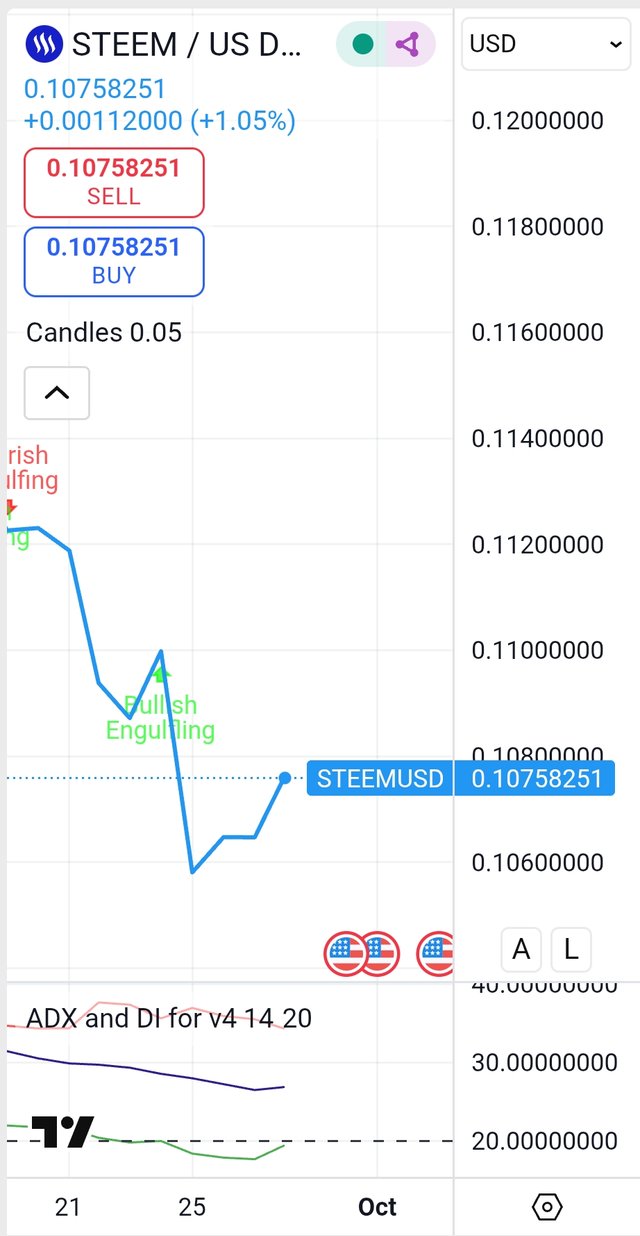1 STEEM = $0.107 USD - How it's engineered for high-throughput, real-time social applications?
The Steem Blockchain (STEEM) is an open-source, decentralized public content platform fundamentally designed to power social media decentralized applications (dApps). Its primary innovation is the direct incentivization of user activity (content creation and curation) through its native cryptocurrency. From a chart pattern perspective, the emergence of a Bullish Engulfing formation suggests a potential shift in market sentiment following a period of decline.
The architecture of Steem is specifically engineered for high-throughput, real-time social applications, utilizing a Delegated Proof-of-Stake (DPoS) consensus mechanism for fast, fee-less transactions. This is critical for scaling social interactions. However, a divergence exists between the on-chain activity and market momentum, as the technical market indicator ADX-DI (Average Directional Index and Directional Movement Indicators) has recently remained in the negative range, suggesting a lack of strong trend and direction in its price action.
The most unique and critical technical feature of the Steem platform is its dynamic reward pool distribution. This mechanism, often termed "Proof-of-Brain," allocates the majority of the token inflation to content creators and curators based on community voting, rather than primarily rewarding the block producers (witnesses), thus directly channeling value back to the application-layer participants.
About Steem Blockchain (STEEM)
The Steem Blockchain (STEEM) is an open-source, decentralized public content platform engineered specifically to power social media and blogging decentralized applications (dApps) by incentivizing user contributions. Launched in 2016, its core innovation lies in the direct integration of a cryptocurrency-based reward system for content creation and curation, a mechanism often referred to as "Proof-of-Brain."
Unique Architectural and Technical Features
The Steem architecture is distinctively tailored for high-throughput social applications, contrasting with blockchains primarily focused on financial transactions.
Delegated Proof-of-Stake (DPoS) Consensus
Steem utilizes a Delegated Proof-of-Stake (DPoS) consensus mechanism. This approach prioritizes speed and scalability, enabling a rapid 3-second block time and supporting near-instant, fee-less transactions. In DPoS, STEEM token holders vote for a fixed set of "witnesses" who are responsible for block production and network security. This delegation allows for faster finality than Proof-of-Work (PoW) or traditional Proof-of-Stake (PoS) systems, a necessity for a real-time social platform.
Tri-Token Cryptoeconomics
The Steem ecosystem operates with three native digital assets, each serving a distinct purpose:
- STEEM: The primary, liquid utility token.
- Steem Power (SP): A vesting token obtained by "powering up" STEEM. SP grants holders increased voting influence over content rewards and governance, aligning incentives for long-term network stake and stability. Unstaking ("powering down") takes a set period.
- Steem Dollars (SBD): A token intended to function as a soft-pegged semi stablecoin, nominally reflecting the value of one US Dollar, designed to offer content creators a predictable value component for their rewards.
Content Incentivization and Reward Distribution
A critical technical feature is the dynamic reward pool distribution. A significant portion of newly generated STEEM inflation is allocated to this pool, which is then distributed to users based on community-driven upvotes (curation) and content creation. The reward split, which historically allocated only a small percentage (e.g., 10%) to the DPoS witnesses and the majority (e.g., 90%) to content creators, curators, and SP holders, is a fundamental shift that directs value back to the application-level participants rather than solely to the underlying infrastructure maintainers (miners/validators).
The Steem Blockchain fundamentally acts as a publicly accessible, immutable database, storing text content alongside transaction data, reward calculations, and payouts, serving as the decentralized backend for dApps like Steemit.
Disclaimer: I’m not a licensed advisor; this is for education only, not financial advice—invest at your own risk and responsibility.
Assisted by https://gemini.google.com/.
See also:
- Reversteem: merges the strategic thrills of classic Reversi with the decentralized power of Steem blockchain, letting you duel friends through blockchain-recorded games
- @steem.amal: Charity At Your Fingertips
- Maximize curation rewards: follow our trail! Maksimalkan reward kurasi: ikuti trail kami! トレイルをフォローし、キユレーション報酬を最大化!
- Pi Network - Crypto Pertama Yang Dapat Ditambang Di Ponsel
- Piネットワーク — スマートフォンでマイニングできる最初の暗号通貨

Upvoted! Thank you for supporting witness @jswit.